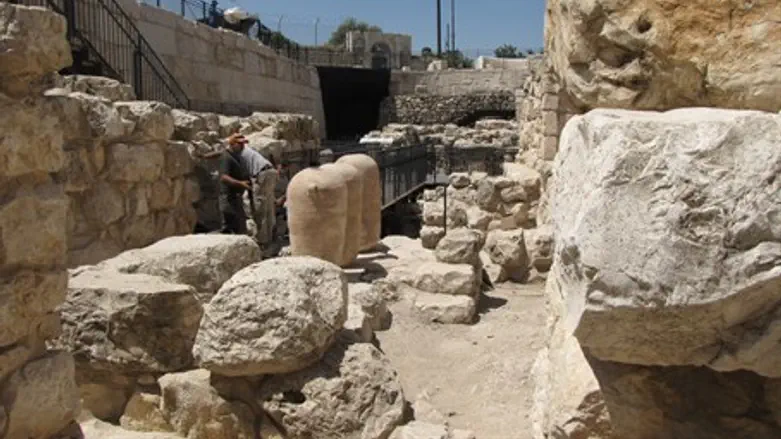
Dr. Eilat Mazar of Hebrew University's archaeology institute spoke to Arutz Sheva about the government's new decision to expand the non-Orthodox mixed prayer section of the Western Wall (Kotel), in the southern part of the Kotel.
Mazar warned that the decision to construct yet another prayer section for Reform Jews, in an expansion of a similar space built in 2013, could prove disastrous for the last remaining area where signs of the destruction of the Second Temple just under 2,000 years ago can be witnessed.
"In the archaeological park at the feet of the Western Wall there is only one section that is exposed and can be viewed. All the rest is underground. This is the southernmost section where the Herodian Quarter from the days of the Second Temple are preserved the way they were," she said.
Mazar added that "in the excavations of my grandfather Professor (Binyamin) Mazar a giant rockslide of the walls that the Romans destroyed on the Temple Mount was discovered."
She noted that the rockslide from the Temple's walls was excavated over the years, and "when they expanded the archaeological park - they moved the southern portion of Herodian road. What remains from all this impressive massive rockslide of these great stones is just a pile of a few dozen meters in a very narrow portion in this section."
The site of the remaining ruins of the Temple walls is exactly the point where the new Reform and Conservative prayer section is planned.
The archaeologist explained that the plan is to take the existing ramp established for the prayer section in 2013 and extend it up to the Kotel, in doing so hiding the rockslide "and not leaving anything from it; maybe it will appear like a sample that will look like a joke but not like historical evidence."
"The person who planned it did so unilaterally without looking at the essential aspect which is the history and the heritage of Jerusalem, which needs to be felt and not just known about. The Kotel is archaeological and historical proof for what was, and what remains here is the very last thing. It isn't possible anywhere in the world to touch the rocks of the destruction (of the Temple) and to see the intensity of this destruction."
"Find another plan"
Mazar called to rethink the plan, noting, "we are talking about a world heritage site, and the fact that it (the plan) wasn't officially announced stems only from political considerations, and the site must under no circumstances be covered and used to find solutions for problems of the day. They must not touch the (archaeological) park."
When asked why there is no international protection for the site which might have prevented the plan, she said that Jerusalem "doesn't receive the protection it deserves in this aspect. ...Who will defend the archaeological heritage of the stones that tell the history of Jerusalem in the most significant way?"
She noted that no other point around the Temple Mount provides such a clear illustration of the destruction of the Temple walls, making the site all the more important, in a point that adds to her argument that the ramp should not be built covering it. Instead she demanded that an alternate plan be drawn up.
"This isn't a place that you can cover and say 'imagine to yourselves what was here.' There are huge stones there, there is the artwork that decorated the Temple Mount and it's all inside the rockslide. ...If there will be a ramp on top of it that will be a total destruction of the appearance. It just can't be done."
Mazar also noted her surprise at the silence over the decision, noting, "I can understand that there are those who want to expand the prayer space, but the length of the Western Wall is 492 meters; why take these 22 meters where the destruction at its height can be seen, a place that is defined as an archaeological site, and implement there (a solution to) this or that prayer problem? Let the experts go and investigate and try to find other solutions."